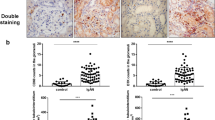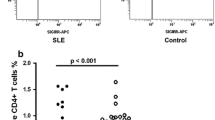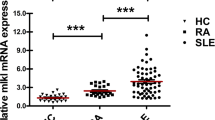Abstract
Systemic lupus erythematosus (SLE) is an autoimmune disease manifested by multiorgan impairment. It is reported that B cells participate in the onset of SLE. Bruton’s tyrosine kinase (Btk), as a downstream signaling molecule of B cell antigen receptor (BCR) signaling pathway, is involved in the development, activation, and survival of B cells. The aim of our study was to explore the specific role of Btk in lupus nephritis (LN). We determined the percentages of Btk+ B cells in peripheral blood mononuclear cells (PBMCs) from SLE patients by flow cytometry and analyzed the correlation between the percentage of Btk+ B cells and lupus-related clinical indexes. Immunohistochemistry was used to detect the Btk expression in kidney from LN patients and tumor surrounding tissues. Compared with controls, the frequency of Btk+ B cells in SLE patients was upregulated (p < 0.01), and it was significantly correlated with the SLE Disease Activity Index (SLEDAI) (p < 0.01), levels of plasma anti-dsDNA antibody (p < 0.05), the amount of 24-h urine protein (p < 0.05), and levels of plasma C3 (p < 0.05). The frequency of Btk+ B cells in the patients with LN was significantly higher than those without LN (p < 0.05). Although the Btk expression in glomerulus of LN patients was significantly increased compared with controls (p < 0.001), but it had no correlation with the renal pathology activity index, SLEDAI, or 24-h urine protein. In conclusion, the increased expression of Btk in peripheral blood was correlated with LN, indicating that it may be a therapeutic target for SLE.





Similar content being viewed by others
References
Lipsky PE (2001) Systemic lupus erythematosus: an autoimmune disease of B cell hyperactivity. Nat Immunol 2:764–766
Pisetsky DS (2000) Anti-DNA and autoantibodies. Curr Opin Rheumatol 12:364–368
Von Muhlen CA, Tan EM (1995) Autoantibodies in the diagnosis of systemic rheumatic diseases. Semin Arthritis Rheum 24:323–358
Khan WN (2009) B cell receptor and BAFF receptor signaling regulation of B cell homeostasis. J Immunol 183:3561–3567
Khan WN (2001) Regulation of B lymphocyte development and activation by Bruton’s tyrosine kinase. Immunol Res 23:147–156
Valiaho J, Smith CI, Vihinen M (2006) BTKbase: the mutation database for X-linked agammaglobulinemia. Hum Mutat 27:1209–1217
Kil LP, De Bruijn MJ, Van Nimwegen M et al (2012) Btk levels set the threshold for B-cell activation and negative selection of autoreactive B cells in mice. Blood 119:3744–3756
Mina-Osorio P, LaStant J, Keirstead N et al (2013) Suppression of glomerulonephritis in lupus-prone NZB x NZW mice by RN486, a selective inhibitor of Bruton’s tyrosine kinase. Arthritis Rheum 65:2380–2391
Rankin AL, Seth N, Keegan S et al (2013) Selective inhibition of BTK prevents murine lupus and antibody-mediated glomerulonephritis. J Immunol 191:4540–4550
Honigberg LA, Smith AM, Sirisawad M, Verner E, Loury D, Chang B, Li S, Pan Z, Thamm DH, Miller RA, Buggy JJ (2010) The Bruton tyrosine kinase inhibitor PCI-32765 blocks B-cell activation and is efficacious in models of autoimmune disease and B-cell malignancy. Proc Natl Acad Sci U S A 107:13075–13080
Smith EL, Shmerling RH (1999) The American College of Rheumatology criteria for the classification of systemic lupus erythematosus: strengths, weaknesses, and opportunities for improvement. Lupus 8:586–595
Weening JJ, D'Agati VD, Schwartz MM et al (2004) The classification of glomerulonephritis in systemic lupus erythematosus revisited. J Am Soc Nephrol 15:241–250
Kamal A, Khamashta M (2014) The efficacy of novel B cell biologics as the future of SLE treatment: a review. Autoimmun Rev 13:1094–1101
Taneichi H, Kanegane H, Sira MM, Futatani T, Agematsu K, Sako M, Kaneko H, Kondo N, Kaisho T, Miyawaki T (2008) Toll-like receptor signaling is impaired in dendritic cells from patients with X-linked agammaglobulinemia. Clin Immunol 126:148–154
Conley ME, Conley ME, Dobbs AK, Farmer DM, Kilic S, Paris K, Grigoriadou S, Coustan-Smith E, Howard V, Campana D (2009) Primary B cell immunodeficiencies: comparisons and contrasts. Annu Rev Immunol 27:199–227
Lopez-Herrera G, Vargas-Hernández A, González-Serrano ME, Berrón-Ruiz L, Rodríguez-Alba JC, Espinosa-Rosales F, Santos-Argumedo L (2014) Bruton’s tyrosine kinase—an integral protein of B cell development that also has an essential role in the innate immune system. J Leukoc Biol 95:243–250
Steinberg BJ, Smathers PA, Frederiksen K, Steinberg AD (1982) Ability of the xid gene to prevent autoimmunity in (NZB X NZW)F1 mice during the course of their natural history, after polyclonal stimulation, or following immunization with DNA. J Clin Invest 70:587–597
Scribner CL, Hansen CT, Klinman DM, Steinberg AD (1987) The interaction of the xid and me genes. J Immunol 138:3611–3617
Seldin MF, Reeves JP, Scribner CL, Roths JB, Davidson WF, Morse HC 3rd, Steinberg AD (1987) Effect of xid on autoimmune C3H-gld/gld mice. Cell Immunol 107:249–255
Satterthwaite AB, Lowell CA, Khan WN, Sideras P, Alt FW, Witte ON (1998) Independent and opposing roles for Btk and lyn in B and myeloid signaling pathways. J Exp Med 188:833–844
Corneth OBJ, Verstappen GMP, Paulissen SMJ et al (2017) Enhanced Bruton’s tyrosine kinase activity in peripheral blood B lymphocytes of autoimmune disease patients. Arthritis Rheum doi. doi:10.1002/art.40059
Nisitani S, Satterthwaite AB, Akashi K et al (2000) Posttranscriptional regulation of Bruton’s tyrosine kinase expression in antigen receptor-stimulated splenic B cells. Proc Natl Acad Sci U S A 97(6):2737–2742
Hutcheson J, Vanarsa K, Bashmakov A et al (2012) Modulating proximal cell signaling by targeting Btk ameliorates humoral autoimmunity and end-organ disease in murine lupus. Arthritis Res Ther 14(6): p. R243
Chalmers SA, Doerner J, Bosanac T et al (2016) Therapeutic blockade of immune complex-mediated glomerulonephritis by highly selective inhibition of Bruton’s tyrosine kinase. Sci Rep. doi:10.1038/srep26164
Acknowledgements
This work was supported by the National Natural Science Foundation of China (No. 81273304, 81401349, 81601414), the fundamental Research Funds for the Central Universities of China (No. 021414340284), and Jiangsu Province Major Research and Development Program (No. BE2015602).
Author information
Authors and Affiliations
Corresponding author
Ethics declarations
All the research with human subjects was in compliance with the Helsinki Declaration. The study was approved by the Ethics Committee of the Nanjing Drum Tower Hospital Clinical College of Nanjing Medical University.
Disclosures
None.
Electronic supplementary material
Rights and permissions
About this article
Cite this article
Kong, W., Deng, W., Sun, Y. et al. Increased expression of Bruton’s tyrosine kinase in peripheral blood is associated with lupus nephritis. Clin Rheumatol 37, 43–49 (2018). https://doi.org/10.1007/s10067-017-3717-3
Received:
Revised:
Accepted:
Published:
Issue Date:
DOI: https://doi.org/10.1007/s10067-017-3717-3




